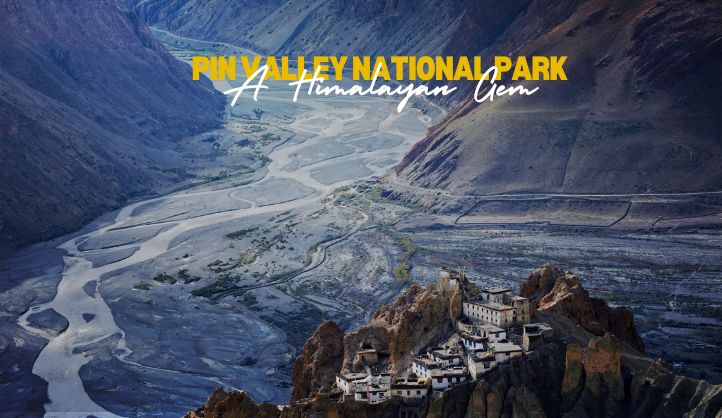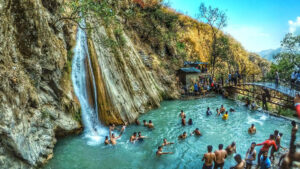In the cold desert region of Himachal Pradesh, Pin Valley National Park is a haven for nature lovers, wildlife enthusiasts, and adventurers alike. Situated in the Spiti Valley, the park showcases a unique blend of rugged terrain, snow-capped peaks, and a diverse range of flora and fauna, making it one of the most picturesque destinations in the Indian Himalayas.
Location and Geography
Pin Valley National Park is located in the Lahaul and Spiti Districts of Himachal Pradesh. It was established in 1987 and covers an area of 675 sq. km, with an additional buffer zone of 1150 sq. km. The park lies at an altitude ranging from 3,500 to 6,000 meters above sea level, offering breathtaking landscapes of arid mountains, glaciers, and river valleys.
The park is named after the Pin River, which flows through its rugged terrain, eventually merging with the Spiti River.
Flora and Fauna
Pin Valley’s biodiversity is remarkable, given its harsh climatic conditions.
Flora
The vegetation here is sparse, dominated by dry alpine scrubs and grassy patches. Some of the key plant species include junipers, Himalayan cedar, and medicinal herbs. During the summer, the park bursts into life with colorful wildflowers, adding to its ethereal beauty.
Fauna
Pin Valley is renowned for its wildlife, particularly its status as a snow leopard reserve. Some of the iconic species found here include:
- Snow Leopard: The elusive and majestic predator, often referred to as the “ghost of the mountains.”
- Himalayan Ibex: Agile mountain goats that thrive in rocky terrains.
- Blue Sheep (Bharal): A vital prey species for snow leopards.
- Tibetan Wolf and Red Fox: Other carnivores that inhabit the park.
The park is also home to over 20 species of animals and 72 species of birds, including the Himalayan Snowcock, Chukar Partridge, and Golden Eagle.
Cultural Significance
Pin Valley is not just a natural sanctuary but also a cultural hub for the local Buddhist communities. The region is dotted with ancient Gompas (monasteries), including the famous Kungri Monastery, which serves as a spiritual center for the Nyingma sect of Tibetan Buddhism.
The local people, primarily of Tibetan descent, have adapted to the extreme climate and contribute to the region’s unique cultural heritage.
Activities and Attractions
- Trekking:
Pin Valley offers some of the most exhilarating trekking routes in the Himalayas, such as:- Pin Parvati Pass Trek: A challenging trail connecting Pin Valley with the Parvati Valley in Kullu.
- Bhaba Pass Trek: Leading to Kinnaur, offering stunning views of glaciers and lush valleys.
- Wildlife Spotting:
Keep an eye out for the snow leopard, especially during the winter when they descend to lower altitudes. - Photography:
The stark contrasts of the arid desert landscape, shimmering snow peaks, and vibrant local culture make Pin Valley a photographer’s paradise. - Cultural Exploration:
Visit the local monasteries and interact with the warm and welcoming locals to gain insight into their way of life.
Best Time to Visit
- Summer (May to September): This is the ideal time to visit, as the weather is relatively mild, and the park is accessible.
- Winter (October to April): While the park is mostly inaccessible due to heavy snowfall, it becomes a hotspot for snow leopard tracking expeditions.
How to Reach
- By Air: The nearest airport is at Bhuntar, approximately 250 km from the park.
- By Road: Pin Valley is well-connected by road to Manali, Kaza, and other major towns in Himachal Pradesh. From Kaza, the park is about 32 km away.
- By Rail: The nearest railway station is at Shimla, around 450 km from the park.
Tips for Visitors
- Pack warm clothing, as temperatures can drop significantly, even in summer.
- Obtain necessary permits from the local authorities in Kaza before entering the park.
- Respect the fragile ecosystem and avoid littering or disturbing wildlife.
- Consider hiring local guides for treks and wildlife spotting.
Nearby Places to Explore
The region surrounding Pin Valley National Park is as captivating as the park itself, offering a mix of natural beauty, cultural richness, and adventure. Here are some remarkable places to explore nearby:
1. Kaza
Kaza, the administrative center of Spiti Valley, is a bustling town surrounded by majestic mountains and barren landscapes. Known for its vibrant culture and strategic location, Kaza serves as a gateway to exploring Spiti’s wonders.
Highlights:
- Key Monastery is a 1,000-year-old Buddhist monastery perched on a hill, offering panoramic views of the valley.
- Sakya Tangyud Monastery: Known for its unique mud-brick construction and spiritual significance.
- Shopping: Explore local markets for traditional handicrafts, woolen items, and Tibetan artifacts.
2. Tabo Monastery
Often called the “Ajanta of the Himalayas,” Tabo Monastery is one of the oldest Buddhist monasteries in India, established in 996 AD. Its ancient murals, stucco sculptures, and intricate frescoes make it a UNESCO World Heritage Site candidate.
Things to Do:
- Marvel at the nine temples, each with its unique architectural and cultural significance.
- Visit the meditation caves used by monks for spiritual retreats.
- Witness the annual Chakhar Festival, a cultural spectacle of the region.
3. Dhankar Monastery and Lake
Perched precariously on a cliff overlooking the confluence of the Spiti and Pin Rivers, Dhankar Monastery is a marvel of ancient Himalayan architecture. Nearby, Dhankar Lake offers a serene trekking destination with breathtaking views of the valley.
Highlights:
- Explore the 1,000-year-old monastery, which is a treasure trove of Buddhist scriptures and relics.
- Take the short trek to Dhankar Lake for an unforgettable view of the Spiti landscape.
4. Kungri Monastery
Kungri Monastery is the second oldest monastery in Spiti Valley and the spiritual center of the Nyingma sect of Tibetan Buddhism. Surrounded by picturesque villages, it offers a glimpse into the local religious practices and culture.
Highlights:
- Attend traditional rituals and festivals celebrated by monks.
- Learn about the ancient Buddhist texts preserved here.
- Enjoy the vibrant Chaam Dance Festival, held annually.
5. Mud Village
Mud Village is a quaint hamlet at the end of the Pin Valley Road. Surrounded by towering peaks, it serves as the starting or ending point for several treks, including the famous Pin Parvati Pass Trek.
Things to Do:
- Experience traditional Spitian hospitality in homestays.
- Relish local cuisine, including Thukpa and Tingmo.
- Enjoy the mesmerizing views of the surrounding mountains.
6. Chandratal Lake
Often referred to as the “Moon Lake,” Chandratal is a crescent-shaped high-altitude lake that captivates visitors with its crystal-clear waters and surrounding alpine meadows.
Things to Do:
- Camp near the lake under a star-studded sky.
- Trek to the lake from Kunzum Pass, a thrilling adventure.
- Capture the changing hues of the lake during sunrise and sunset.
7. Langza Village
Langza is one of Spiti’s most picturesque villages, known for its ancient fossils and the towering statue of Lord Buddha overlooking the valley.
Things to Do:
- Fossil hunting in the nearby hills.
- Visit the Langza Buddha Statue, a serene site amidst stunning landscapes.
- Experience the rural lifestyle of Spiti Valley.
8. Hikkim
Hikkim is famous for housing the world’s highest post office. Sending a postcard from here is a unique experience.
Highlights:
- Visit the iconic post office and interact with the postmaster.
- Explore the surrounding snow-laden terrain during winter.
- Enjoy sweeping views of the Spiti Valley.
9. Komic Village
At an altitude of 4,587 meters, Komic is one of the highest villages in the world connected by a motorable road. It offers unmatched views of Spiti’s rugged terrain.
Things to Do:
- Visit the Komic Monastery, known for its serene ambiance.
- Witness the simplicity of life in one of the world’s remotest villages.
- Spot rare wildlife like the Himalayan wolf and blue sheep.
10. Kunzum Pass
Kunzum Pass is a high-altitude mountain pass that connects Spiti Valley with Lahaul Valley. At an altitude of 4,551 meters, it offers panoramic views of snow-capped peaks and glaciers.
Highlights:
- Stop at the Kunzum Mata Temple for blessings.
- Capture stunning photographs of the pass and its surroundings.
- Enjoy the thrill of driving through one of the highest motorable passes.
Conclusion
Pin Valley National Park is a treasure trove of natural and cultural wonders, offering an unparalleled experience of the high-altitude desert ecosystem. Whether you are seeking adventure, serenity, or a closer connection with nature, this Himalayan gem has something for everyone. Plan your visit to Pin Valley to immerse yourself in its breathtaking landscapes and rich biodiversity.
FAQs About Pin Valley National Park
1. What is the best time to visit Pin Valley National Park?
The best time to visit Pin Valley National Park is between May and September. The weather is pleasant during this period, and the park is accessible. Winter months (October to April) bring heavy snowfall, making the area inaccessible, but it becomes a hub for snow leopard tracking during this time.
2. How do I reach Pin Valley National Park?
- By Air: The nearest airport is Bhuntar Airport, located about 250 km away.
- By Road: The park is well-connected to Kaza (32 km away), which is accessible via Manali or Shimla.
- By Rail: The closest railway station is Shimla, approximately 450 km from the park.
From Kaza, you can hire a taxi or take a local bus to reach Pin Valley.
3. What are the main attractions of Pin Valley National Park?
- Wildlife: Spot the elusive snow leopard, Himalayan ibex, blue sheep, and various bird species like the Himalayan snowcock and golden eagle.
- Trekking: Routes like the Pin Parvati Pass Trek and the Bhaba Pass Trek offer adventure opportunities.
- Kungri Monastery: Explore this cultural and spiritual landmark in the valley.
- Scenic Beauty: Admire the stunning landscapes of cold deserts, glaciers, and the Pin River.
4. Do I need a permit to visit Pin Valley National Park?
Yes, Inner Line Permits (ILP) are required for international tourists to visit Spiti Valley, including Pin Valley National Park. These permits can be obtained from the DC Office in Shimla, Kaza, or Manali. Indian nationals generally do not require permits but should carry valid identification.
5. What kind of wildlife can I see in Pin Valley National Park?
Pin Valley is renowned for its diverse wildlife, particularly in its harsh alpine desert environment. Common species include:
- Snow Leopard
- Himalayan Ibex
- Tibetan Wolf
- Red Fox
- Blue Sheep (Bharal)
The park is also home to over 72 species of birds, making it a bird-watcher’s paradise.





